Cactus Search (Virus Removal Instructions) - Free Guide
Cactus Search Removal Guide
What is Cactus Search?
Cactus Search – a heavily advertised browser plugin that will bombard your searches with ads

Cactus Search is a potentially unwanted program developed to force you into using a search engine of its choice. It does that by making modifications to your browser settings. This browser hijacker changes the default search engine, which results in an altered new tab and homepage preferences.
When you install Cactus Search browser hijacker, all of the abovementioned settings are changed to promote cactus-search.com. That's a fake search engine, as it doesn't generate any search results. Users are redirected with their search inquiries to other websites.
Browser hijackers usually show results from legitimate sources like Google, Yahoo, and others, but with a slight twist. By causing redirects, these PUPs inject ads into search results. These ads can cause the most damage as they could lead to malicious portals. This article explains how this browser hijacker works, its risks, and how to remove it.
| name | Cactus Search |
|---|---|
| Type | Browser hijacker, redirect virus, PUP |
| Altered browser settings | The default search engine, new tab, homepage |
| Promote fake search site | cactus-search.com |
| IP address | 104.31.90.247 |
| Symptoms | All searches going through a new search engine. The new tab and homepage are changed. Slower browsing speed and device performance |
| Risks | Browser hijackers can cause redirects to hazardous affiliated pages where users might encounter scams, malware, push notification viruses, fake updates, etc. |
| Distribution | Google Chrome Web Store, freeware, deceptive ads, fake Flash Player updates |
| Removal | To safely terminate any threat, you must use a reliable anti-malware tool |
| System Repair | It would be best if you used the powerful FortectIntego system tune-up tool to completely eliminate any traces of the Cactus Search from your device |
Browser hijackers are usually falsely advertised as tools that will boost the internet connection, improve privacy and safety while browsing, etc. When in fact, they do the exact opposite by overloading your connection and collecting various browsing-related information, including:
- geolocations,
- device and browser details,
- used apps,
- search inquiries,
- search history, etc.
These details are usually shared with advertisers to show you customized ads. But non-personal[1] data collection might still pose dangers. One more shady function of Cactus Search virus is that it injects ads into search results shown from legitimate sources.
Its developers state that the shown ads will help to save the planet. While that might be true, you can't know what affiliated pages will you be redirected to when Cactus Search ads are pressed. PUP developers might unknowingly advertise a hazardous website.
Which may include porn, gambling, malware, fake updates, scams, and sites with other ill intentions. And lastly, Cactus Search redirect could force you to visit questionable sites without you clicking any buttons, search results, or ads. Therefore, we highly advise not installing this PUP.

If you already did, then you came to the right place to find out how to safely remove Cactus Search. First, you will need a trustworthy security tool. If you don't own one, free anti-malware tools like SpyHunter 5Combo Cleaner and Malwarebytes will be more than enough. Open either of those tools, initiate a full system scan, and stick with the app recommendations on what to eliminate when it's finished.
As great as AV tools are with Cactus Search removal, they can't delete it from the Registry and other core system directories and settings. Thus cybersecurity experts[2] highly recommend using the all-in-one FortectIntego system diagnostics tool that will fully eliminate this PUP from your device and delete tracking cookies in the process.
Attentiveness to software installation might prevent PUP infections
People usually don't know how their devices got infected with adware,[3] browser hijackers, unnecessary toolbars, and other potentially unwanted programs. That's because PUP developers use stealthy techniques to distribute their worthless but harmful creations.
Software bundling is one of the most popular of those methods. These packs containing an installer for more than one app are usually downloaded from third-party software vendors. To avoid PUPs from bundles, you have to choose to either download all your software directly from its developers or stay cautious when installing it.
If you choose the second option, remember not to rush. All apps are preselected for installation, so please remember not to select the Recommended/Quick mode. Take your time and pick the Advanced/Custom mode and go through the list of apps that would be automatically installed if you'd have chosen otherwise.
Then go step-by-step, deselecting each and every app that raises any questions, looks shady, or you just don't need it. Install only the software that you wanted in the first place. Please remember this short manual, and your device will be much safer.

Remove Cactus Search virus with security tools to ensure it's completely gone
Adware and browser hijackers, including Cactus Search virus, are deemed as potentially unwanted programs, but they might act as a bridge to malware infections, such as Trojans, ransomware, etc. Thus they shouldn't be joked with and terminated immediately before more harm came your way.
You can remove Cactus Search by scanning your device with a trustworthy security tool. Such software should always be updated to prevent any PUPs and malware from gaining access to your machine. If the PUP was installed as a browser extension, use our guides below to delete it.
Altered system files and settings may lead to sluggish performance, crashes, freezing, and other abnormal device behavior. To terminate any traces of and finish Cactus Search removal, you should consider using a compatible system diagnostics tool.
You may remove virus damage with a help of FortectIntego. SpyHunter 5Combo Cleaner and Malwarebytes are recommended to detect potentially unwanted programs and viruses with all their files and registry entries that are related to them.
Getting rid of Cactus Search. Follow these steps
Uninstall from Windows
Instructions for Windows 10/8 machines:
- Enter Control Panel into Windows search box and hit Enter or click on the search result.
- Under Programs, select Uninstall a program.
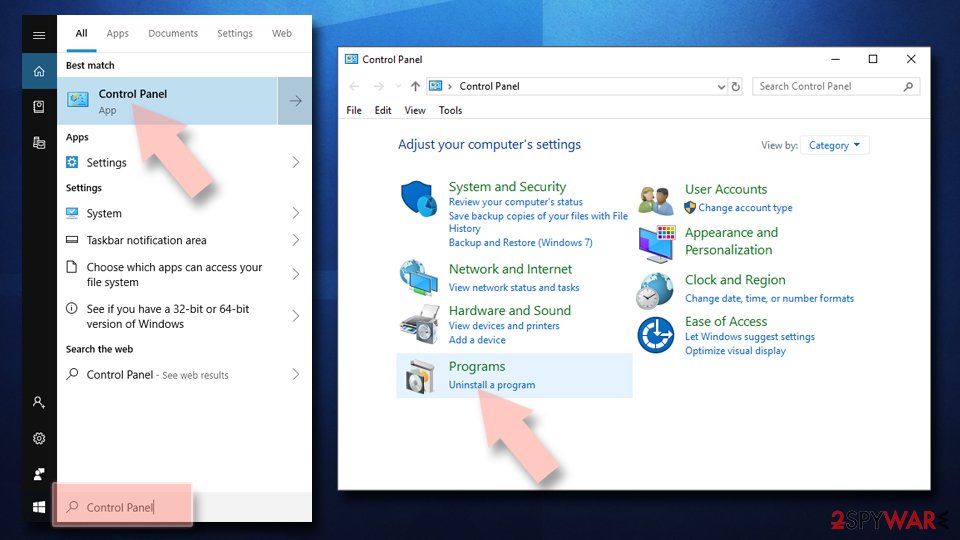
- From the list, find the entry of the suspicious program.
- Right-click on the application and select Uninstall.
- If User Account Control shows up, click Yes.
- Wait till uninstallation process is complete and click OK.
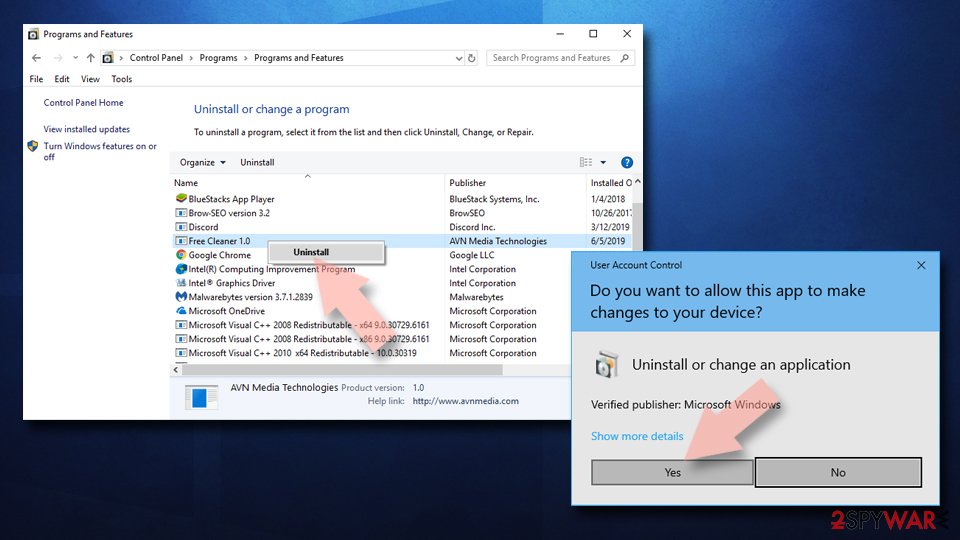
If you are Windows 7/XP user, proceed with the following instructions:
- Click on Windows Start > Control Panel located on the right pane (if you are Windows XP user, click on Add/Remove Programs).
- In Control Panel, select Programs > Uninstall a program.
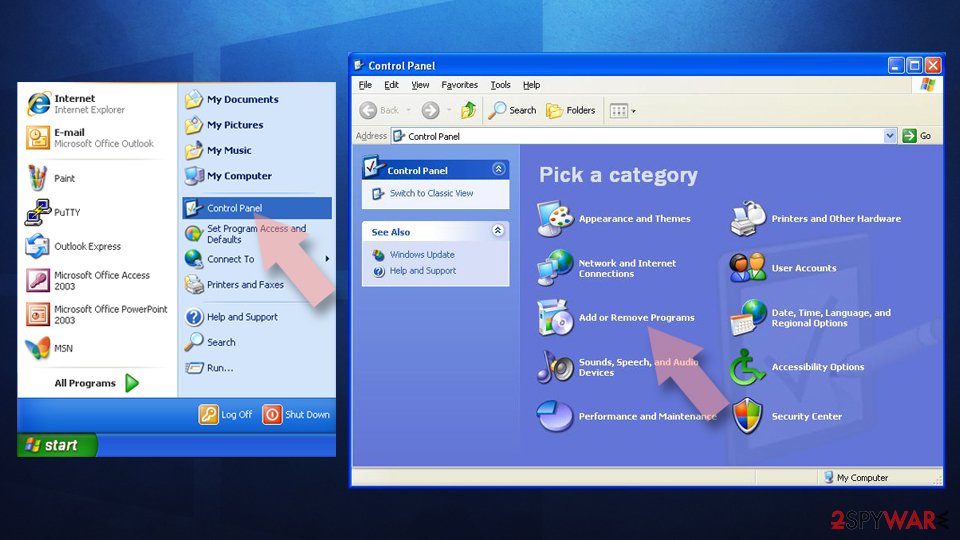
- Pick the unwanted application by clicking on it once.
- At the top, click Uninstall/Change.
- In the confirmation prompt, pick Yes.
- Click OK once the removal process is finished.
Delete from macOS
Remove items from Applications folder:
- From the menu bar, select Go > Applications.
- In the Applications folder, look for all related entries.
- Click on the app and drag it to Trash (or right-click and pick Move to Trash)
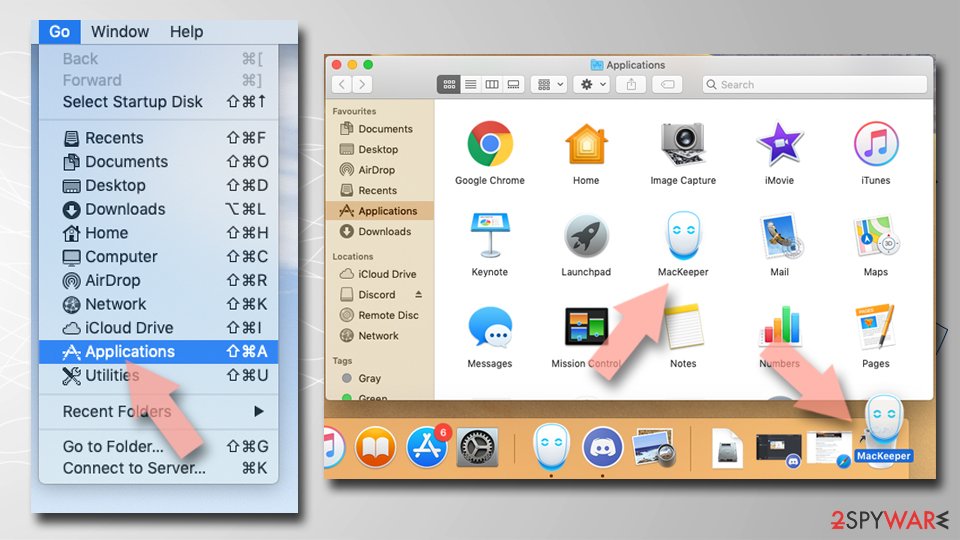
To fully remove an unwanted app, you need to access Application Support, LaunchAgents, and LaunchDaemons folders and delete relevant files:
- Select Go > Go to Folder.
- Enter /Library/Application Support and click Go or press Enter.
- In the Application Support folder, look for any dubious entries and then delete them.
- Now enter /Library/LaunchAgents and /Library/LaunchDaemons folders the same way and terminate all the related .plist files.

Remove from Microsoft Edge
Delete unwanted extensions from MS Edge:
- Select Menu (three horizontal dots at the top-right of the browser window) and pick Extensions.
- From the list, pick the extension and click on the Gear icon.
- Click on Uninstall at the bottom.
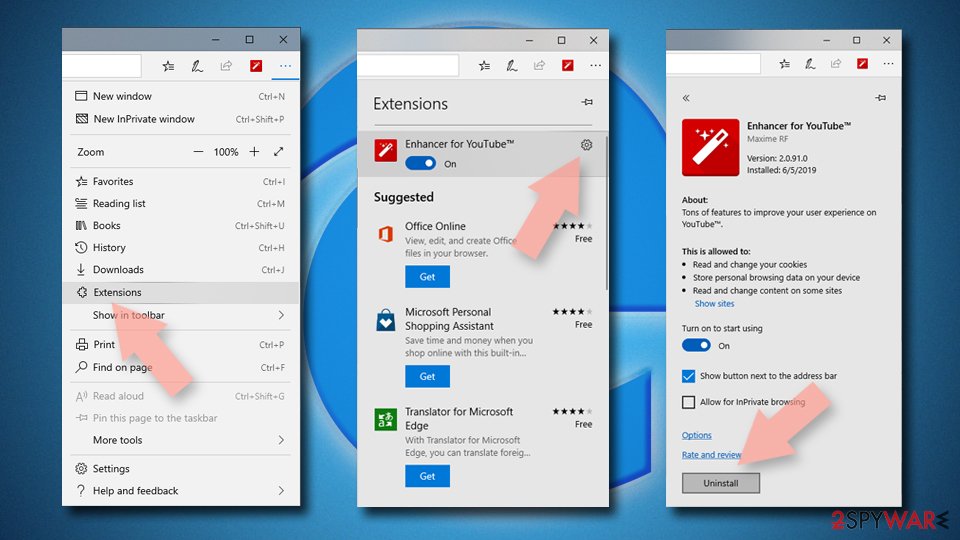
Clear cookies and other browser data:
- Click on the Menu (three horizontal dots at the top-right of the browser window) and select Privacy & security.
- Under Clear browsing data, pick Choose what to clear.
- Select everything (apart from passwords, although you might want to include Media licenses as well, if applicable) and click on Clear.
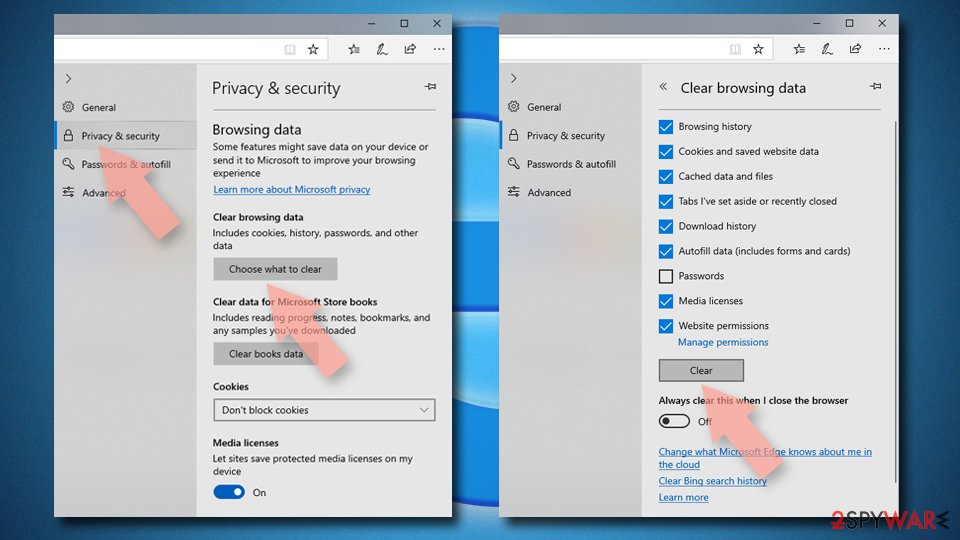
Restore new tab and homepage settings:
- Click the menu icon and choose Settings.
- Then find On startup section.
- Click Disable if you found any suspicious domain.
Reset MS Edge if the above steps did not work:
- Press on Ctrl + Shift + Esc to open Task Manager.
- Click on More details arrow at the bottom of the window.
- Select Details tab.
- Now scroll down and locate every entry with Microsoft Edge name in it. Right-click on each of them and select End Task to stop MS Edge from running.
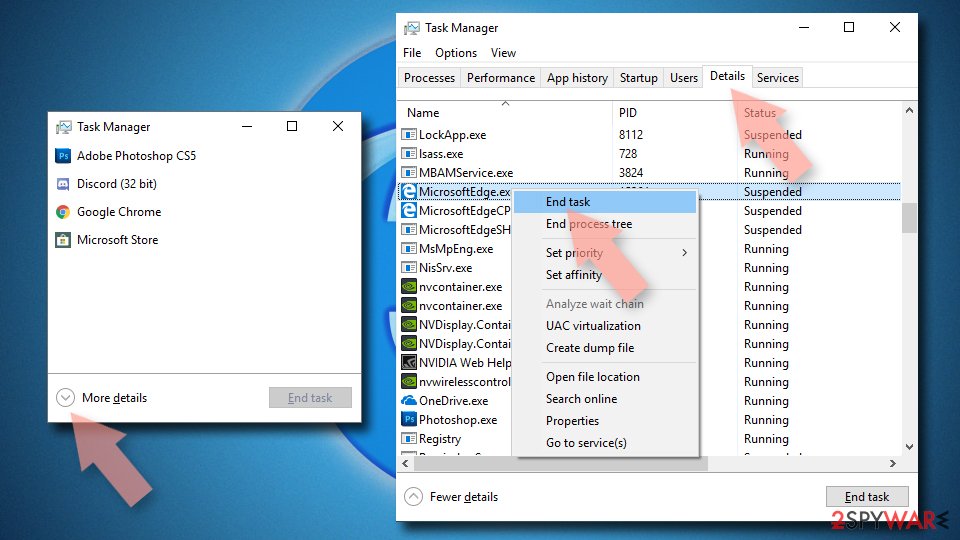
If this solution failed to help you, you need to use an advanced Edge reset method. Note that you need to backup your data before proceeding.
- Find the following folder on your computer: C:\\Users\\%username%\\AppData\\Local\\Packages\\Microsoft.MicrosoftEdge_8wekyb3d8bbwe.
- Press Ctrl + A on your keyboard to select all folders.
- Right-click on them and pick Delete
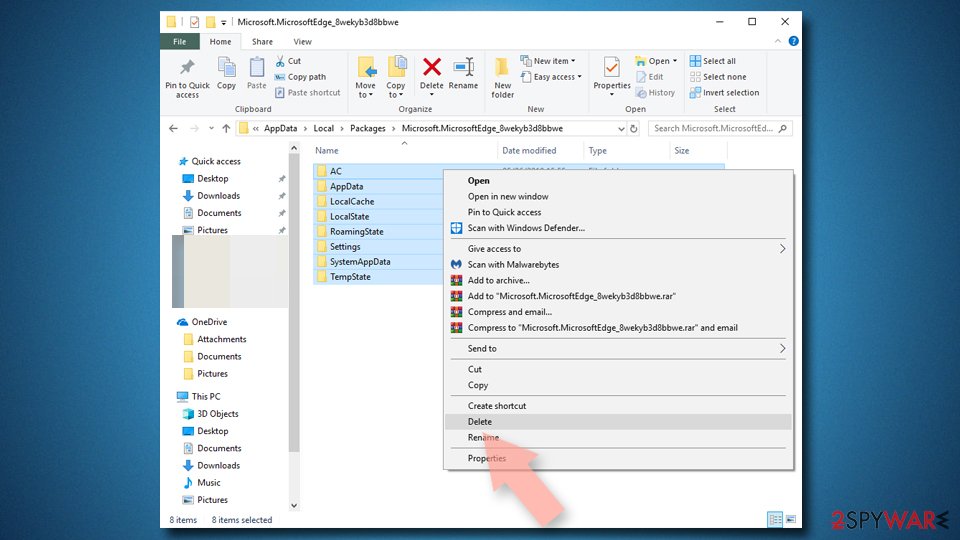
- Now right-click on the Start button and pick Windows PowerShell (Admin).
- When the new window opens, copy and paste the following command, and then press Enter:
Get-AppXPackage -AllUsers -Name Microsoft.MicrosoftEdge | Foreach {Add-AppxPackage -DisableDevelopmentMode -Register “$($_.InstallLocation)\\AppXManifest.xml” -Verbose
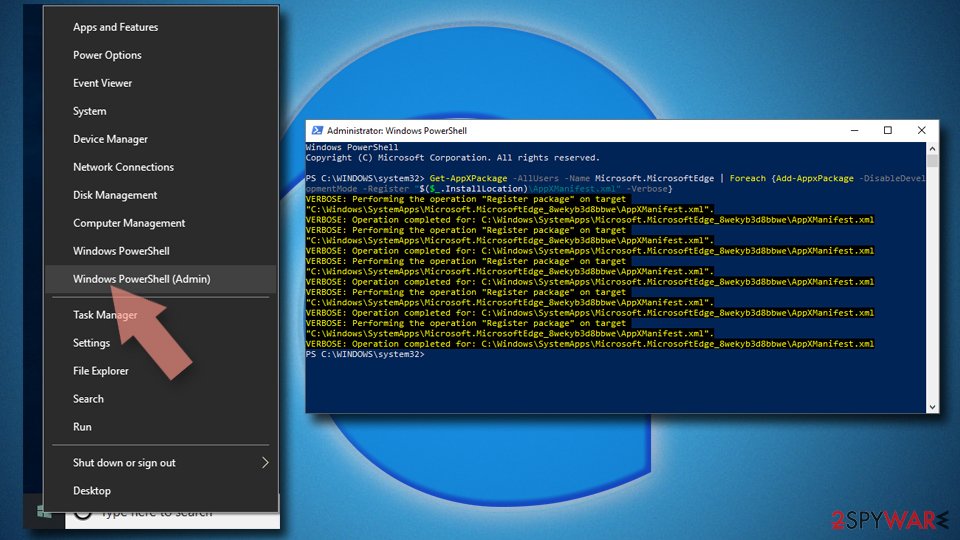
Instructions for Chromium-based Edge
Delete extensions from MS Edge (Chromium):
- Open Edge and click select Settings > Extensions.
- Delete unwanted extensions by clicking Remove.
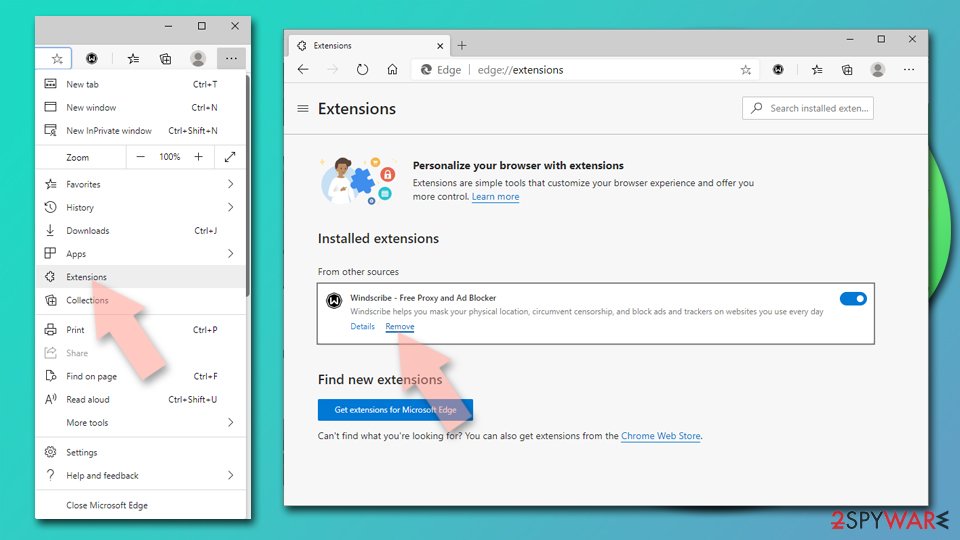
Clear cache and site data:
- Click on Menu and go to Settings.
- Select Privacy, search and services.
- Under Clear browsing data, pick Choose what to clear.
- Under Time range, pick All time.
- Select Clear now.
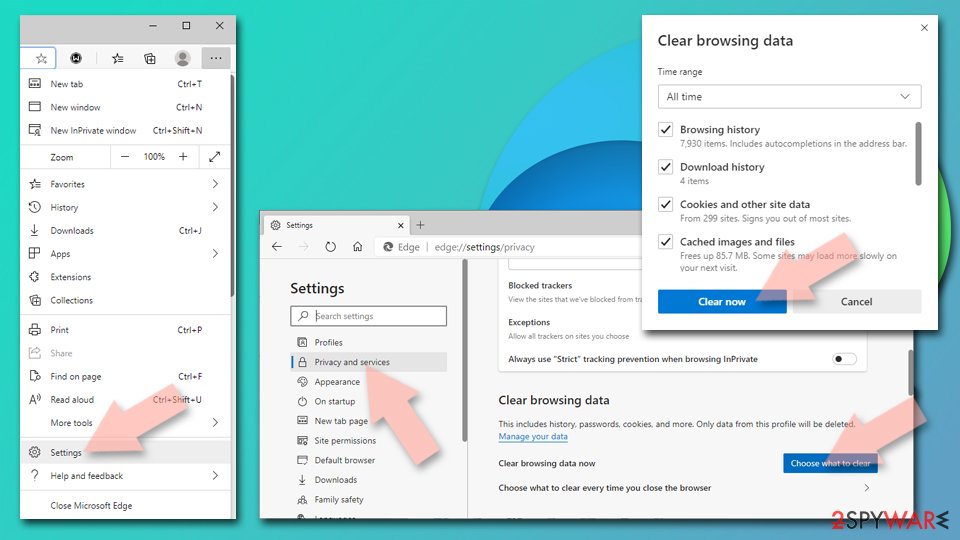
Reset Chromium-based MS Edge:
- Click on Menu and select Settings.
- On the left side, pick Reset settings.
- Select Restore settings to their default values.
- Confirm with Reset.
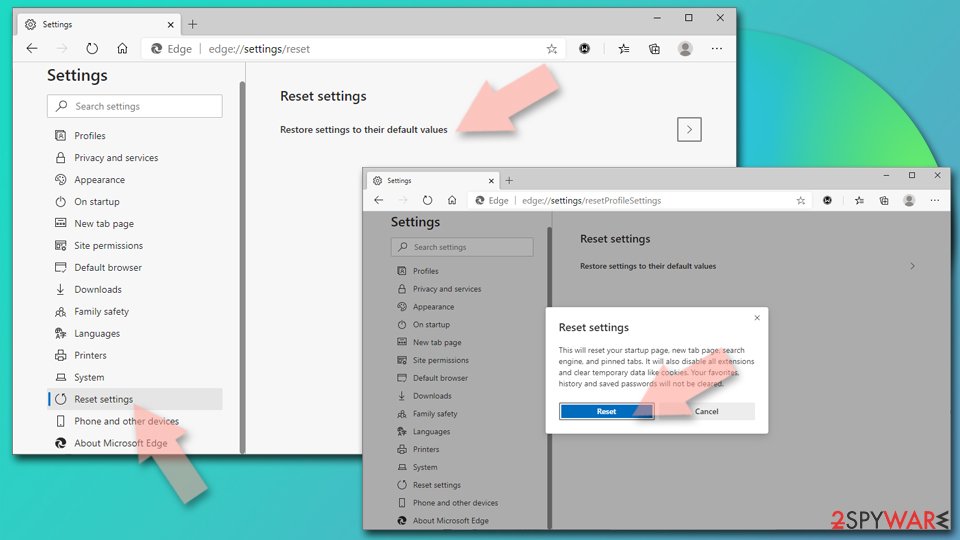
Remove from Mozilla Firefox (FF)
Remove dangerous extensions:
- Open Mozilla Firefox browser and click on the Menu (three horizontal lines at the top-right of the window).
- Select Add-ons.
- In here, select unwanted plugin and click Remove.
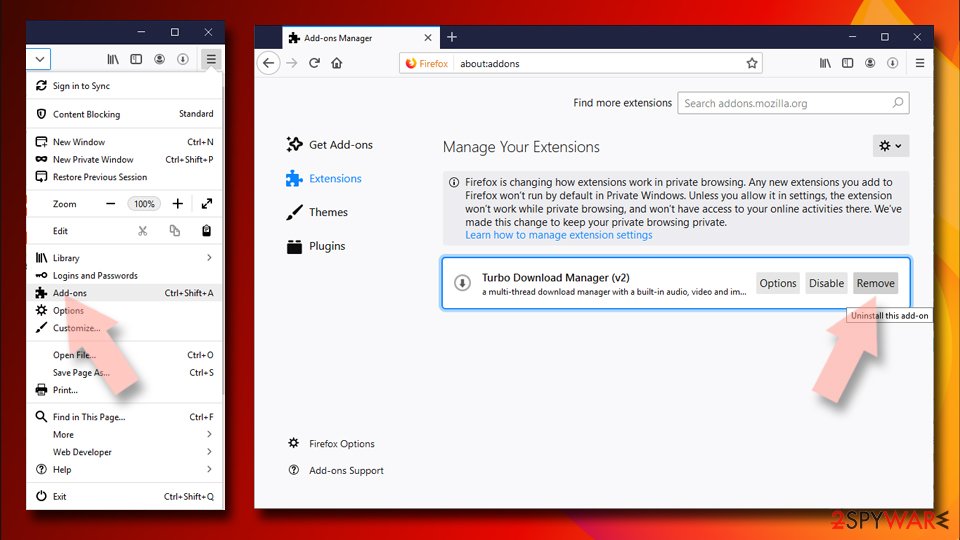
Reset the homepage:
- Click three horizontal lines at the top right corner to open the menu.
- Choose Options.
- Under Home options, enter your preferred site that will open every time you newly open the Mozilla Firefox.
Clear cookies and site data:
- Click Menu and pick Settings.
- Go to Privacy & Security section.
- Scroll down to locate Cookies and Site Data.
- Click on Clear Data…
- Select Cookies and Site Data, as well as Cached Web Content and press Clear.
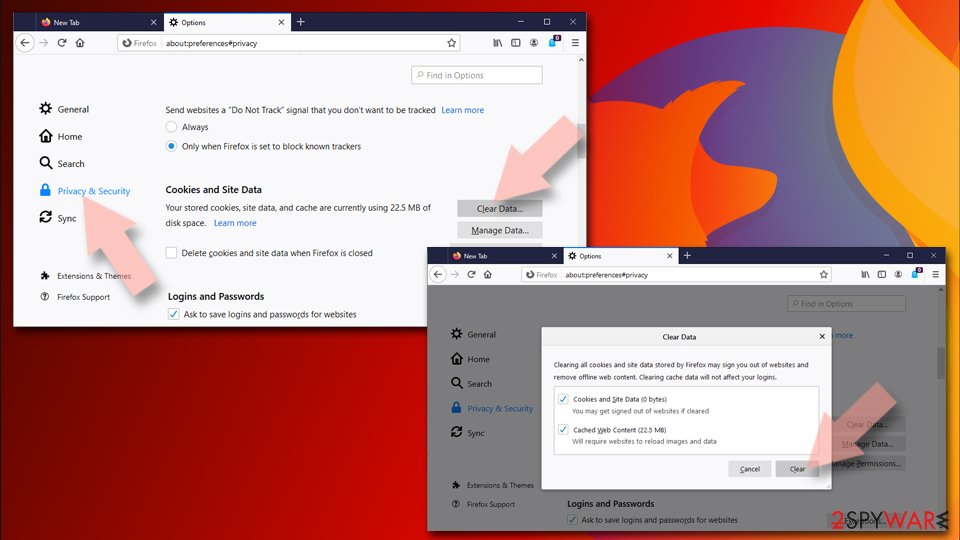
Reset Mozilla Firefox
If clearing the browser as explained above did not help, reset Mozilla Firefox:
- Open Mozilla Firefox browser and click the Menu.
- Go to Help and then choose Troubleshooting Information.
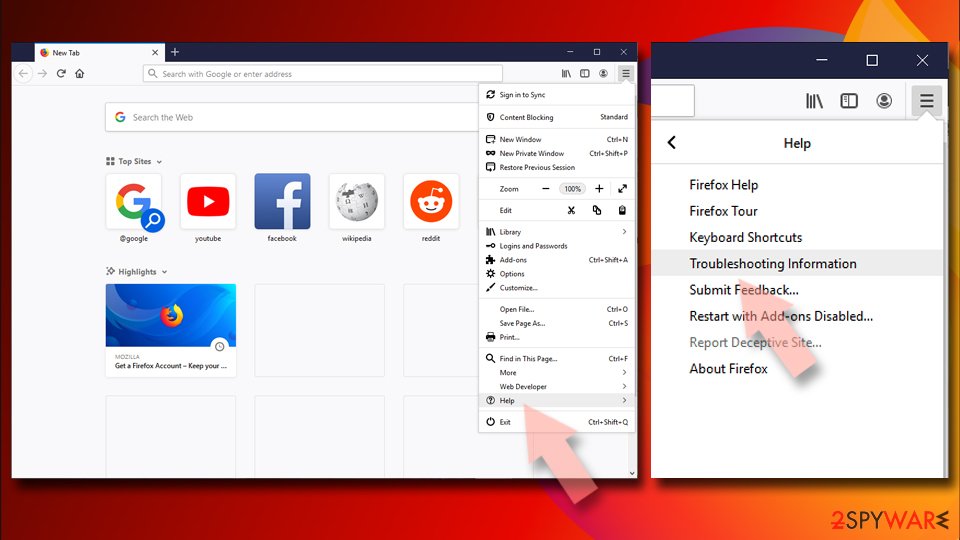
- Under Give Firefox a tune up section, click on Refresh Firefox…
- Once the pop-up shows up, confirm the action by pressing on Refresh Firefox.
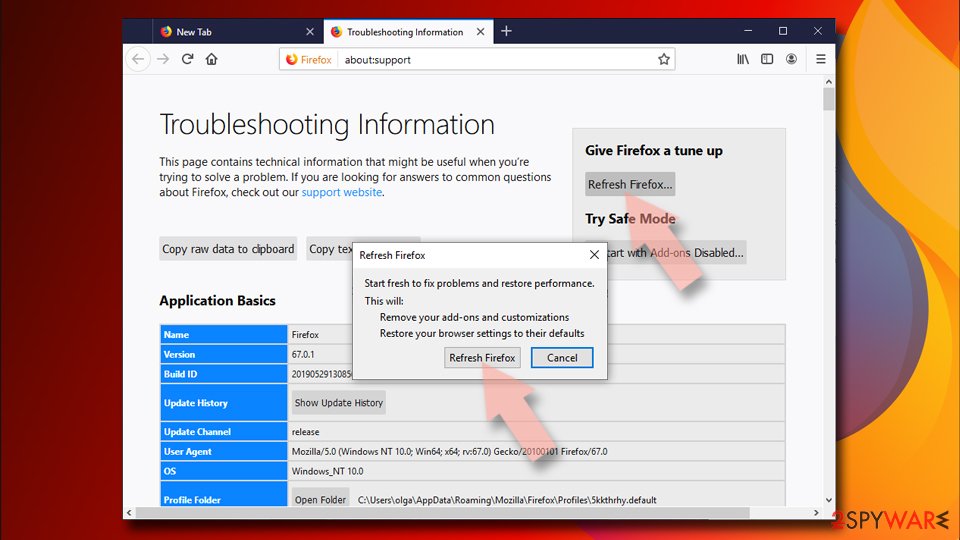
Remove from Google Chrome
Delete malicious extensions from Google Chrome:
- Open Google Chrome, click on the Menu (three vertical dots at the top-right corner) and select More tools > Extensions.
- In the newly opened window, you will see all the installed extensions. Uninstall all the suspicious plugins that might be related to the unwanted program by clicking Remove.
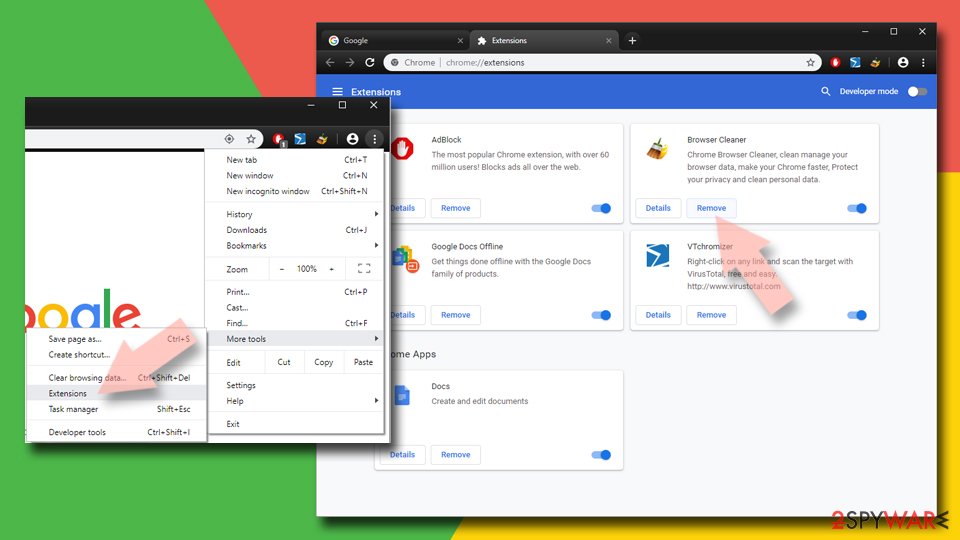
Clear cache and web data from Chrome:
- Click on Menu and pick Settings.
- Under Privacy and security, select Clear browsing data.
- Select Browsing history, Cookies and other site data, as well as Cached images and files.
- Click Clear data.
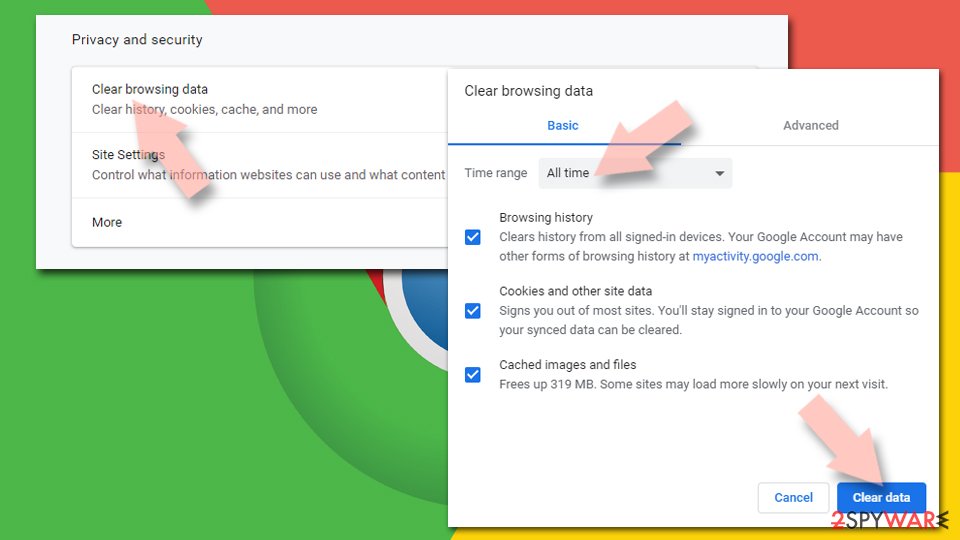
Change your homepage:
- Click menu and choose Settings.
- Look for a suspicious site in the On startup section.
- Click on Open a specific or set of pages and click on three dots to find the Remove option.
Reset Google Chrome:
If the previous methods did not help you, reset Google Chrome to eliminate all the unwanted components:
- Click on Menu and select Settings.
- In the Settings, scroll down and click Advanced.
- Scroll down and locate Reset and clean up section.
- Now click Restore settings to their original defaults.
- Confirm with Reset settings.
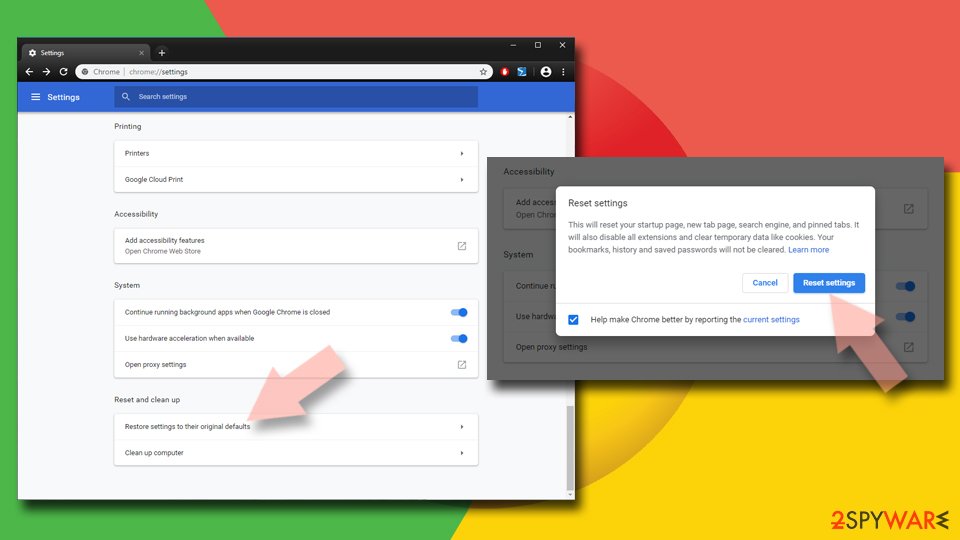
Delete from Safari
Remove unwanted extensions from Safari:
- Click Safari > Preferences…
- In the new window, pick Extensions.
- Select the unwanted extension and select Uninstall.
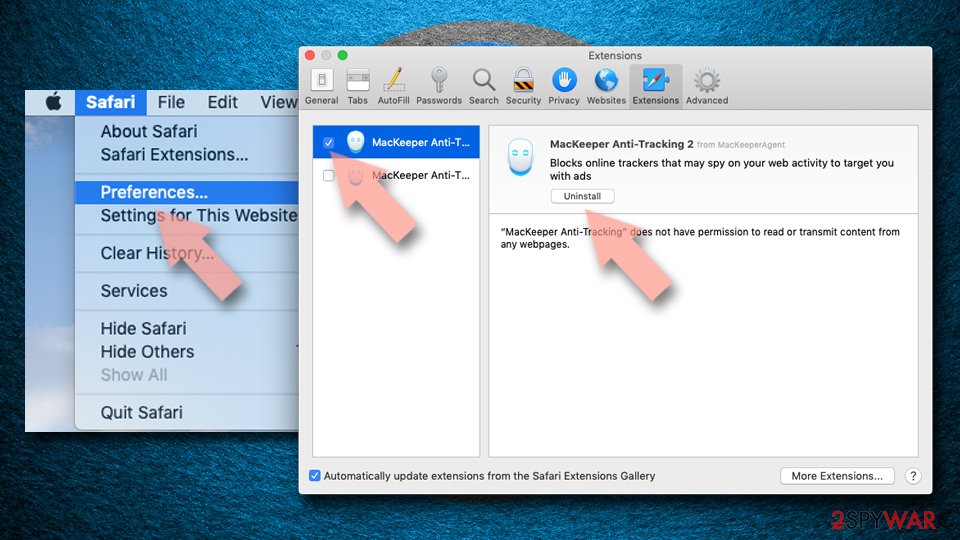
Clear cookies and other website data from Safari:
- Click Safari > Clear History…
- From the drop-down menu under Clear, pick all history.
- Confirm with Clear History.
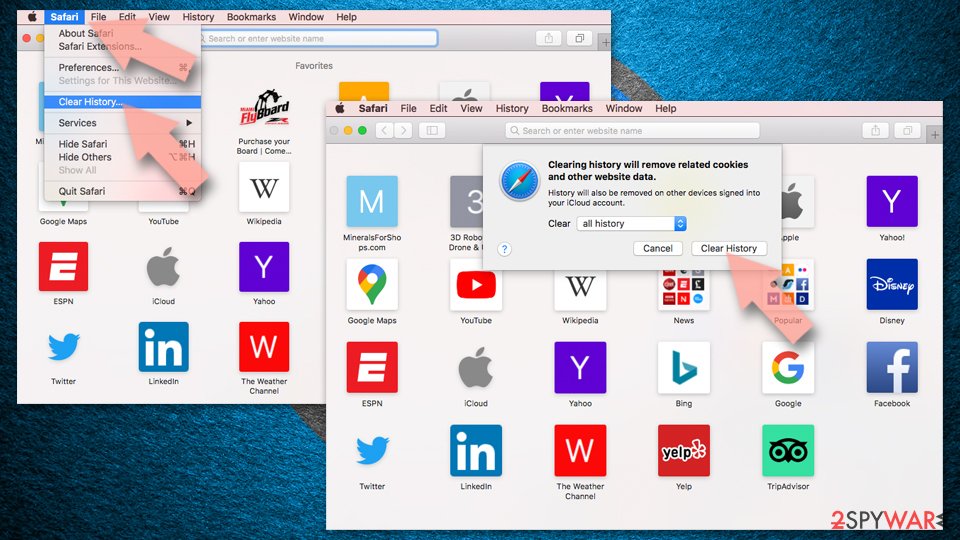
Reset Safari if the above-mentioned steps did not help you:
- Click Safari > Preferences…
- Go to Advanced tab.
- Tick the Show Develop menu in menu bar.
- From the menu bar, click Develop, and then select Empty Caches.
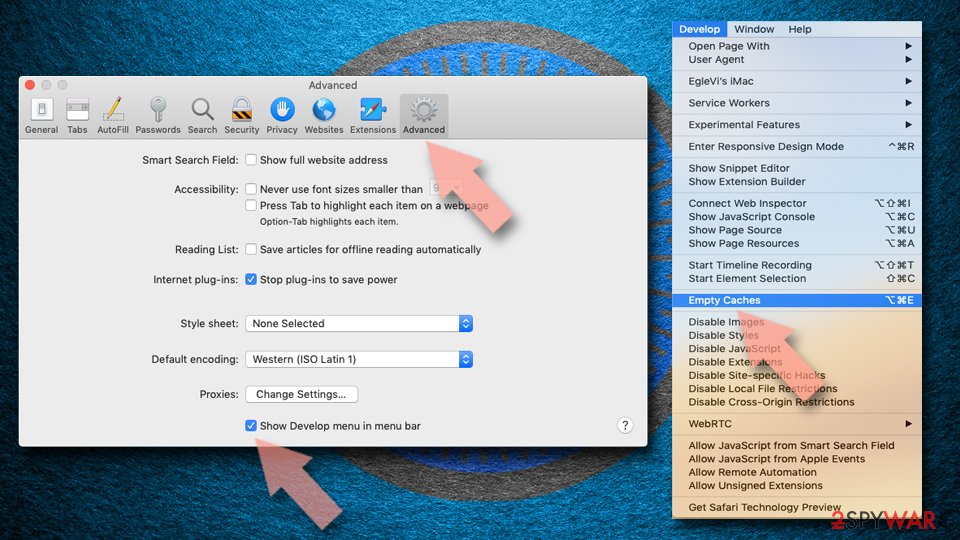
After uninstalling this potentially unwanted program (PUP) and fixing each of your web browsers, we recommend you to scan your PC system with a reputable anti-spyware. This will help you to get rid of Cactus Search registry traces and will also identify related parasites or possible malware infections on your computer. For that you can use our top-rated malware remover: FortectIntego, SpyHunter 5Combo Cleaner or Malwarebytes.
How to prevent from getting browser hijacker
Protect your privacy – employ a VPN
There are several ways how to make your online time more private – you can access an incognito tab. However, there is no secret that even in this mode, you are tracked for advertising purposes. There is a way to add an extra layer of protection and create a completely anonymous web browsing practice with the help of Private Internet Access VPN. This software reroutes traffic through different servers, thus leaving your IP address and geolocation in disguise. Besides, it is based on a strict no-log policy, meaning that no data will be recorded, leaked, and available for both first and third parties. The combination of a secure web browser and Private Internet Access VPN will let you browse the Internet without a feeling of being spied or targeted by criminals.
No backups? No problem. Use a data recovery tool
If you wonder how data loss can occur, you should not look any further for answers – human errors, malware attacks, hardware failures, power cuts, natural disasters, or even simple negligence. In some cases, lost files are extremely important, and many straight out panic when such an unfortunate course of events happen. Due to this, you should always ensure that you prepare proper data backups on a regular basis.
If you were caught by surprise and did not have any backups to restore your files from, not everything is lost. Data Recovery Pro is one of the leading file recovery solutions you can find on the market – it is likely to restore even lost emails or data located on an external device.
